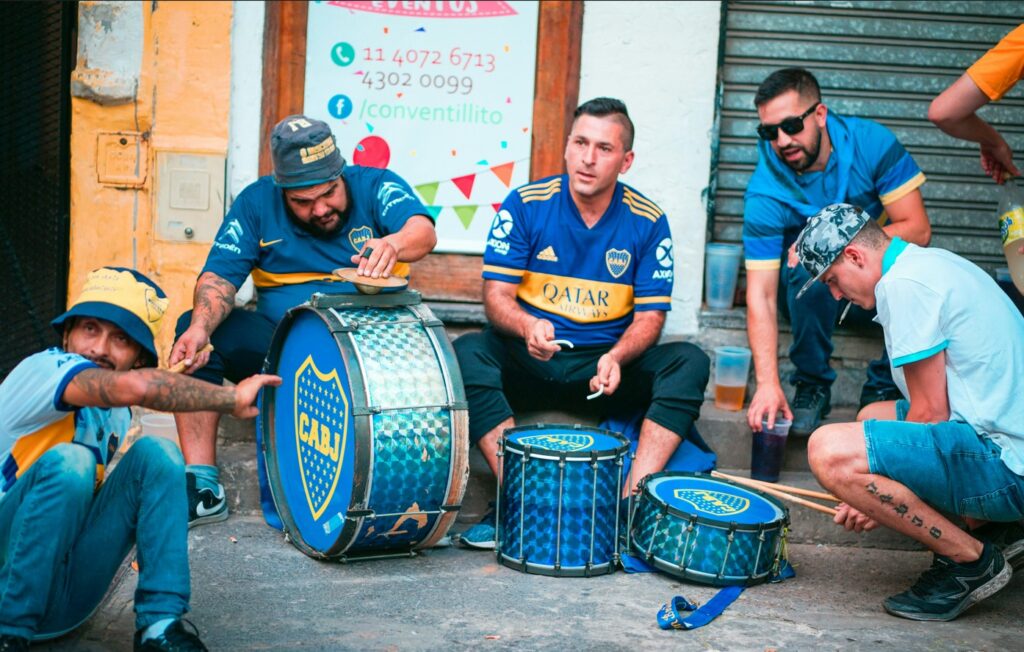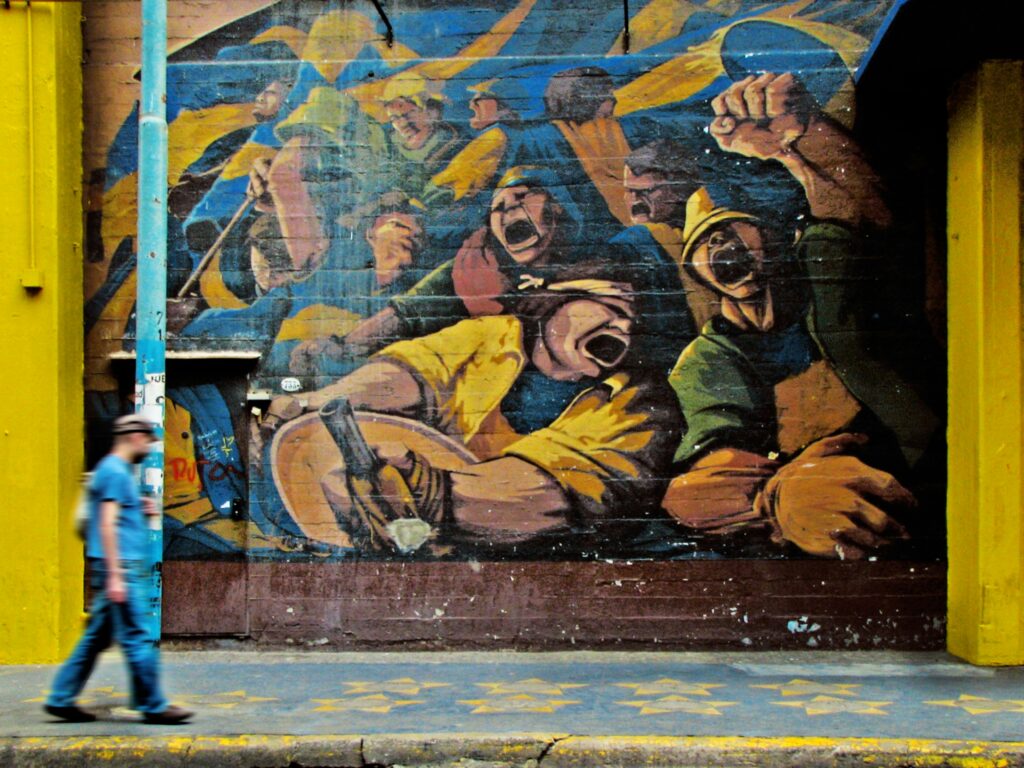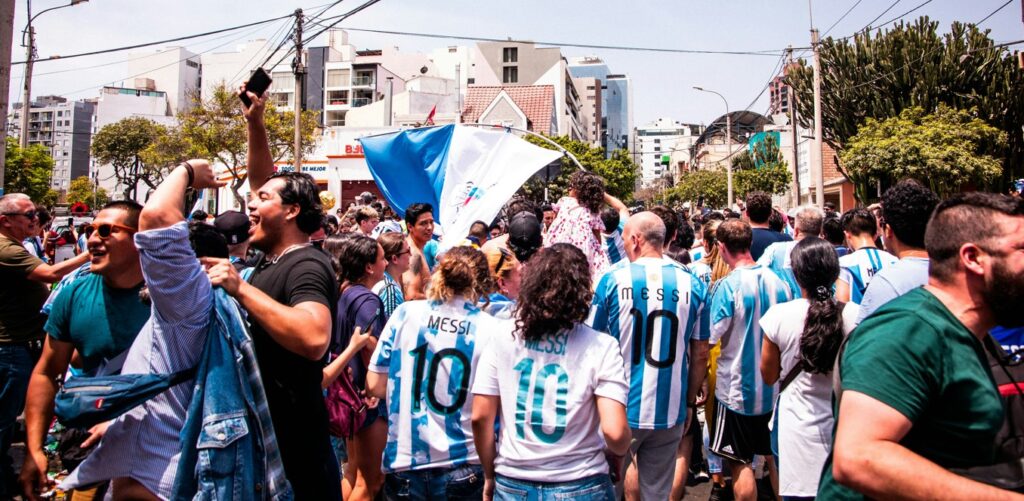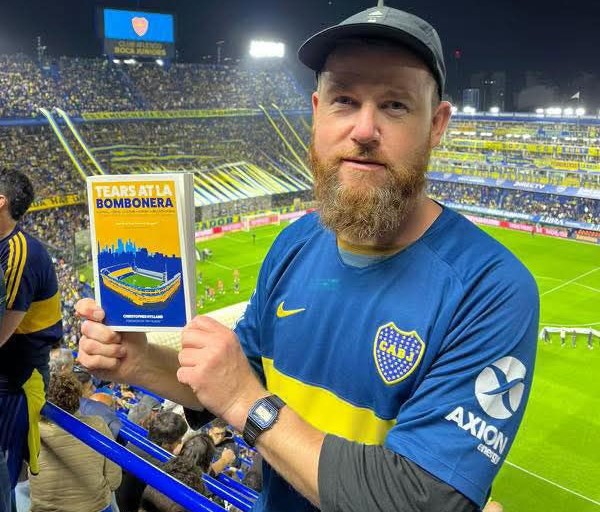The first time Christopher Hylland attended the Superclásico in Argentina, he cried. Not out of fear, or even joy, but just down to the sheer intensity of it all.
The deafening noise, the sea of blue and yellow bouncing in unison, the crackle of flares lighting up the night sky, it was sensory overload in the best possible way.
Struggling to catch his breath as bedlam unfolded around him, Hylland felt tears stream down his face and fall onto the concrete steps of La Bombonera.
Hylland tells The Kit Room Collective how that teary night in Buenos Aires laid the emotional foundation for Tears at La Bombonera, a book that captures his six-year sojourn through South America, where the kits were as much a part of the rivalry as the noise
Starting in Argentina, Hylland spent four years in the land of silver, and the Boca-River rivalry was simply its crescendo.
“The football almost feels like an inconvenience
“The real experience happens outside the stadium, the noise, the colour, the chaos. By the time you’re inside, the match can be quite dull,” Hylland says.
“I went to a Boca-River game where the first goal came in the 85th minute. Before that, it was all about the party on the streets. They call it carnival, it’s their escape from a hard week, a hard life. That’s what makes football so important over there.

“There’s a word, aguante, which means enduring support. Fans believe their presence can drive the team forward. At the World Cup, Argentina’s loss to Saudi Arabia was partly blamed on a lack of aguante in the stands. That’s how deeply they believe passion influences performance.
But the fire of Boca versus River isn’t just about the game, it’s born from a history of cultural and social tension that still burns today.
“Going back right from the beginning, they came from the same neighbourhood. Riverplate were born in the same neighbourhood, La Boca.
“The idea is they played a game to decide who should stick around and who should move, and Boca won.
“River Plate eventually moved to wealthier neighborhoods like Palermo and Núñez, while Boca stayed in the working-class area. But despite this, both clubs have homogeneous fanbases that span all social classes.”
The passion and roar fill the air on matchday, but the true spectacle is the colors; Boca’s deep blue and gold against River’s crisp white and red, a visceral, iconic rivalry all on its own.
“It’s something I mentioned in the second book, but there’s something special about that derby because both teams always wear the same colours.
“So you can say the stadiums are iconic. Yeah, they’re bucket list places. The players have been incredibly iconic; Riquelme, Tevez, Crespo, etc. But the images that you have of these players, inevitably they’re always with the yellow bar across the Boca shirt and the red sash across the white shirt.
“That constant visual contrast makes the rivalry instantly recognizable.”
Much like the club’s origins, the colours they have become synonymous with are also tales steeped in tradition, lore, and lasting symbolism.
“River Plate’s colors are believed to come from an Italian regional flag, likely Liguria, reflecting the origins of many Italian immigrants who passed through the port of Genoa,” Hylland explains.
“Boca Juniors, on the other hand, experimented with many kit colors early on, including Juventus-style black and white stripes and even pink.
“The story goes that they decided to adopt the colors of the next ship to sail into the harbor, which happened to be a Swedish flag. Since then, Boca has embraced that blue and gold, sometimes even wearing kits boldly displaying the Swedish flag.”

Over here, football fans’ fashion can sometimes be quite muted; black jackets, Stone Island, low-key looks. But in Argentina there’s no fear in flaunting colour and kits are often worn by fans like a proud badge of honour, but this wasn’t always the case.
“There haven’t been any away fans in Argentina for about 12 years or so now. I think the reality is that over the last 12 years, a lot more families, a lot more women have been comfortable going to the games, and therefore, they’re a lot more comfortable wearing their shirts and their colours, because the level of violence has reduced massively.
“I think there’s a real freedom in wearing your colours now. People are proud of them, why wouldn’t you be?”
Hylland reveals, a large number of these kits are probably replicas or fakes, but that doesn’t lessen the passion behind wearing them.
“A large aspect of Argentinian football is the fake shirts. The fake shirts are so good, simply for the fact that there’s a price parity. I think they call it PPP, whereby, an Adidas shirt or a Nike shirt costs the same basis in every single country around the world. But then, if you’re living in a poor country, how on earth do you have to afford 50 to 80 euros for a football shirt?”
Since that teary night at La Bombonera, Hylland has witnessed over ten more Superclásicos and journeyed through Peru, Brazil, Bolivia, Colombia, and beyond, yet it’s Argentina that has stayed with him the most.
“For a football nut, Buenos Aires is probably the best place to start your travels. They call it the ‘gringo trail’, a route mostly north to south, from Colombia down to Argentina.
“For me, Buenos Aires was the only place that really got me. It might sound like a cliché, but if you spend more than a couple of weeks there, there’s no shortage of football indulgence. You can dive into football before even seeing the typical tourist spots.
“Even Brazil, with its love of football, looks at Argentina and thinks, ‘We’d love to be like them.’ Despite the rivalry and language differences, a lot of football culture and passion in Brazil borrows from Argentina.”

And while some might approach La Boca with caution, Hylland urges people to look past the misconceptions and experience the soul of a neighbourhood that lives and breathes football, colour, and community.
“You’re not interrupting their carnival or party. They’re in their own world, grilling food, drinking fernet with Coca-Cola. Things happen everywhere, but I’d happily walk La Boca in daylight.”
In a city where football is stitched into the soul, pride doesn’t fade with defeat but it grows louder and more visible.
“One thing I actually noticed was after a Boca Juniors loss to River Plate, or the other way around, the next day you’d see loads of fans wearing the losing team’s shirt.
“It’s like they’re almost more proud to wear it, knowing they’ll get some teasing or stick for it. But they wear it anyway.
“It represents a lot of the city in general: a kind of defiance, pride, and strength in the face of struggle.”

